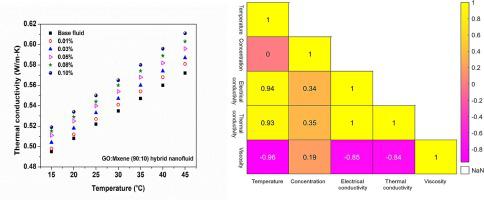FlatChem ( IF 6.2 ) Pub Date : 2024-01-03 , DOI: 10.1016/j.flatc.2023.100606 Praveen Kumar K , K. Deepthi Jayan , Prabhakar Sharma , Mansoor Alruqi

|
Recent research has extensively focused on 2D materials such as graphene oxide (GO) and MXene due to their intriguing properties, significantly advancing nanotechnology and materials research. This experimental study explores the use of a vanadium electrolyte-based hybrid nanofluid (HNF) composed of GO and MXene (90:10) to enhance vanadium redox flow batteries (VRFBs). The synthesis and characterization of GO and Mxene nanoparticles (NPs) were conducted using various techniques. The HNF, produced at different weight concentrations, underwent analysis for stability, rheology, thermal conductivity (TC), and electrical conductivity (EC) within a temperature range of 10–45 °C. The results indicate that the HNF exhibits favorable stability and Newtonian behavior in the specified temperature range. At 45 °C, the HNF achieves a maximum enhancement of 20.5 % in EC and 6.81 % in TC for 0.1 wt% compared to the vanadium electrolyte. Subsequently, a prognostic model was developed using an explainable ensemble LSBoost-based machine learning approach, employing a test dataset and applying 5-fold cross-validation to prevent overfitting. Hyperparameter optimization was achieved using the Bayesian technique. The LSBoost-based prognostic models created for TC, EC, and viscosity (VST) demonstrated high effectiveness, with R2 values of 0.9981, 0.99, and 0.9954, respectively. The prediction errors were minimal, with RMSE values of 0.00089255, 5.553, and 0.09391 for the TC, EC, and VST models, respectively. Similarly, the MAE values were low, at 0.00068948, 4.0919, and 0.06129.
中文翻译:

用于钒氧化还原液流电池的氧化石墨烯和MXene混合纳米流体的热电流变特性:可解释的集成机器学习与超参数优化的应用
最近的研究广泛集中在氧化石墨烯 (GO) 和 MXene 等二维材料上,因为它们具有有趣的特性,显着推进了纳米技术和材料研究。本实验研究探索使用由 GO 和 MXene (90:10) 组成的基于钒电解质的混合纳米流体 (HNF) 来增强钒氧化还原液流电池 (VRFB)。GO 和 Mxene 纳米颗粒 (NP) 的合成和表征采用多种技术进行。以不同重量浓度生产的 HNF 在 10-45 °C 的温度范围内进行稳定性、流变性、导热性 (TC) 和电导率 (EC) 分析。结果表明,HNF 在特定温度范围内表现出良好的稳定性和牛顿行为。在 45 °C 时,与钒电解质相比,0.1 wt% 的 HNF 的 EC 最大提高了 20.5%,TC 最大提高了 6.81%。随后,使用可解释的基于 LSBoost 的集成机器学习方法开发了一个预后模型,采用测试数据集并应用 5 倍交叉验证来防止过度拟合。使用贝叶斯技术实现了超参数优化。针对 TC、EC 和粘度 (VST) 创建的基于 LSBoost 的预测模型表现出很高的有效性,R 2值分别为 0.9981、0.99 和 0.9954。预测误差很小,TC、EC 和 VST 模型的 RMSE 值分别为 0.00089255、5.553 和 0.09391。同样,MAE 值也较低,分别为 0.00068948、4.0919 和 0.06129。



























 京公网安备 11010802027423号
京公网安备 11010802027423号